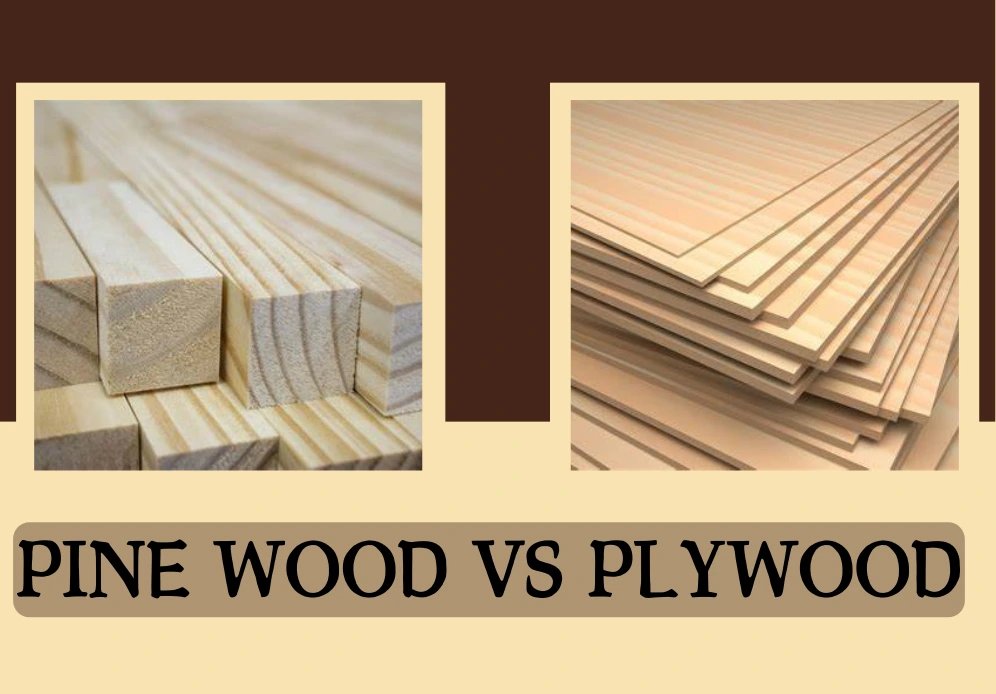When undertaking a woodworking project or home renovation, selecting the right material is crucial for achieving the desired results. Pine wood vs plywood are two commonly used materials, each with unique characteristics.
This guide provides a detailed comparison to help you make an informed choice between pine wood and plywood, ensuring your project meets your aesthetic, functional, and budgetary needs.
What Is Pinewood? Its Characteristics And Advantages
Pine wood is softwood from pine trees. It is light in color, straight-grained, and finds its application in several woodworking projects. Being abundant and easy to work with, pine is one of the most common woods for making furniture, cabinets, and moldings.
Characteristics Of Pinewood
- Natural Beauty: Pinewood features a warm, natural appearance that can be enhanced with different stains and finishes. Its light color adds a bright and airy feel to any space.
- Workability: Pine is relatively soft compared to hardwoods, making it easy to cut, shape, and sand. This ease of use is ideal for both professionals and DIY enthusiasts.
- Affordability: Pine is generally less expensive than many hardwoods, making it a cost-effective option for various projects.
Advantages Of Pinewood
- Aesthetic Appeal: The natural grain and color of pine wood are visually pleasing and versatile, suitable for a range of design styles.
- Ease of Use: Due to its softness, pine is easier to work with, making it a popular choice for intricate designs and detailed craftsmanship.
- Cost-Effective: Pine is one of the more affordable wood options, allowing for budget-friendly projects without sacrificing quality.
What Is Plywood? Its Characteristics And Advantages
Plywood is an engineered wood product made from thin layers, or “plies,” of wood veneers glued together in alternating directions. This construction method enhances the material’s strength and stability, making it a versatile choice for various applications, from construction to furniture making.
Characteristics Of Plywood
- Strength and Stability: Plywood’s cross-laminated construction provides excellent strength and resistance to warping, making it suitable for structural applications.
- Consistent Quality: Unlike solid wood, plywood offers a uniform surface free of knots and defects, ensuring a consistent finish and performance.
- Versatility: Available in various grades and thicknesses, plywood can be tailored to meet specific needs, whether for furniture, cabinetry, or flooring.
Advantages Of Plywood
- Durability: Plywood is more resistant to warping, cracking, and splitting compared to solid wood, making it a durable choice for many applications.
- Structural Integrity: The cross-laminated layers of plywood contribute to its structural strength, making it ideal for uses that require load-bearing capabilities.
- Variety: Plywood comes in different grades, finishes, and thicknesses, allowing for customization based on project requirements and aesthetic preferences.
Choose MRS Woodcraft for all your plywood needs and experience why it’s famous as the best plywood company in India.
Pine wood vs Plywood: Key Differences
When selecting materials for furniture or construction, pine wood vs plywood often come to mind. Both materials are versatile but cater to different needs.
1. Material Composition
- Pine Wood: Solid wood derived directly from pine trees. It is natural and features unique grain patterns.
- Plywood: Engineered wood made by gluing thin layers of wood veneers together. It’s a composite material, offering uniform strength.
2. Strength and Durability
- Pine Wood: Offers natural strength but can dent or scratch easily due to its softness.
- Plywood: More resistant to warping, splitting, or cracking because of its cross-layered structure.
3. Appearance and Finish
- Pine Wood: Displays a natural, rustic look with visible knots and grains. It can be stained or painted for aesthetic enhancement.
- Plywood: Has a plain surface. Veneers or laminates are often added to improve its appearance.
4. Cost
- Pine Wood: Typically more expensive because it is solid, natural wood.
- Plywood: More affordable, especially for large projects, since it is made from layers of wood rather than a single piece.
5. Applications
- Pine Wood: Best for furniture, decorative items, and projects requiring natural wood aesthetics.
- Plywood: Ideal for structural uses like flooring, cabinets, or walls, where strength is prioritized over appearance.
MRS Woodcraft is a great option if you’re looking to buy Pinewood or Plywood. We offer both at affordable prices without compromising on quality. You can contact us on WhatsApp or fill out this form to learn more about their pricing.
Conclusion
Your choice could fall between pine wood vs plywood, depending on what your project requires, the budget, and even the type of look desired.
Pinewood possesses an inherent natural beauty and is soft, hence easy to work with, making it ideal for furniture and other decorative pieces.
On the contrary, plywood is resistant and strong enough to be used in structural applications that are subjected to heavy traffic. Knowing the strengths and limitations of both materials paves the way for making an informed decision that will guarantee the success and satisfaction of your project.
Frequently Asked Questions
Can Plywood Be Used For Exterior Applications?
Plywood can be used for exterior applications if it is treated or finished to withstand weather conditions. Marine-grade plywood, specifically designed for outdoor use.
Is Plywood A Good Choice For Furniture Making?
Yes, plywood would work for furniture, especially for those furniture pieces that require structural strength and stability.
Can I Use Pine Wood For Outdoor Projects?
Pinewood does not undergo treatment and cannot be used outdoors without proper finishing. Being a softwood, pine is incredibly sensitive to moisture.
Is Pine Wood More Durable Than Plywood?
Therefore, plywood is better for applications that require a great level of durability, since pinewood is from softwood trees, thus being easily scratched or dented.
Can I Combine Pine Wood vs Plywood In A Single Project?
Yes, many projects use both to balance aesthetics and cost.

